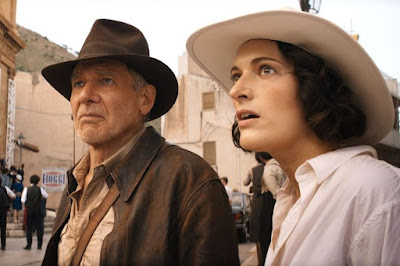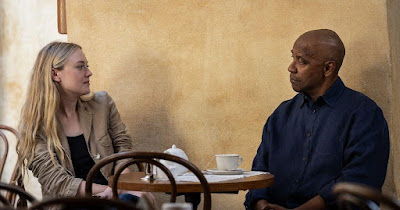Daredevil archaeologist Indiana Jones races against time to retrieve a legendary dial that can change the course of history. Accompanied by his goddaughter, he soon finds himself squaring off against Jürgen Voller, a former Nazi who works for NASA.
Since his iconic debut as the adventurous archaeologist in 1981's Raiders of the Lost Ark, Indiana Jones has captivated audiences with his daring escapades, whip-cracking skills, and a certain timeless charm. Now, in the fifth instalment of the series, Indiana Jones and the Dial of Destiny, directed by James Mangold, the titular character is back for one last ride. While the film delivers on the expected action and retro nostalgia, it struggles to find a balance between homage and originality, resulting in an entertaining but somewhat uneven experience.
The film opens with a visually impressive sequence set during World War II, showcasing the de-ageing technology used to portray a younger Harrison Ford. Unlike previous attempts in other films, such as Captain Marvel and The Irishman, the CGI techniques employed here are notably more effective, although Ford's unmistakable gravelly voice does occasionally undercut the illusion. The sequence is a thrilling reminder of the franchise's adventurous roots, and it's a testament to Mangold's direction that he captures the essence of the series while making his mark.
As the story unfolds, we find an older Indiana Jones living a somewhat weary existence in 1969, a far cry from his glory days. Harrison Ford, donning his fedora once again, showcases his enduring charm and curmudgeonly persona, which has become a hallmark of the character. The film takes a brief pause to explore the emotional weight Indy carries, including his estrangement from Marian (Karen Allen) and the loss of his son in the Vietnam War. These glimpses into Indy's personal struggles add depth to his character, but the film's pacing occasionally falters as it shifts between action and introspection.
Phoebe Waller-Bridge shines as Helena, Indy's goddaughter, who ropes him back into adventure. Her charismatic presence injects fresh energy into the series, and her chemistry with Ford adds a delightful dynamic to the film. The supporting cast, including Mads Mikkelsen as the enigmatic villain, complements the central performances, although the choice to once again use Nazis as antagonists is somewhat uncomfortable given the current global context.
What should have been a weakness, but turned into one of the film's weaknesses is its visual effects, which have not significantly improved since the franchise's earlier attempts. The action sequences are grand in scale, featuring daring chases and explosive encounters that pay homage to the series' legacy. However, the reliance on relentless action lacks substance, and leads to a sense of monotony, making it challenging to fully invest in the outcome of each set piece.
The film's central artefact, the Dial of Destiny, an astronomical calculator with time-bending powers, serves as the driving force behind the narrative. While the concept is intriguing, the plot occasionally loses coherence as it ventures into the realm of time travel. The transition from archaeological adventure to temporal manipulation feels jarring and at odds with the franchise's established tone.
Mangold's direction is competent, capturing the essence of Indiana Jones' adventurous spirit while infusing some of his own style into the mix. Yet, the film's pacing and structure occasionally feel disjointed, with a string of action scenes strung together without a strong narrative thread to connect them. The result is an experience that, while visually engaging, lacks the emotional resonance that made the earlier films so memorable.
In terms of nostalgia, Indiana Jones and the Dial of Destiny hits the right notes, transporting audiences back to a bygone era of adventure cinema. However, its attempts to balance homage with originality often result in a clash of tones. The film seems torn between adhering to the formula that made the series successful and attempting to break new ground. This struggle is particularly evident in the way the film treats its villains, relying on the iconography of the Nazis while failing to establish them as compelling adversaries.
In conclusion, Indiana Jones and the Dial of Destiny offers a serviceable thrill ride that showcases Harrison Ford's enduring charisma and the franchise's classic adventurous spirit. James Mangold's direction brings a fresh perspective to the series, and Phoebe Waller-Bridge's inclusion injects new life into the narrative. The film's visual effects and action sequences are a feast for the eyes, even if the relentless pacing sometimes leads to viewer fatigue.
While the movie succeeds in invoking nostalgia and capturing the essence of the Indiana Jones franchise, it falls short in terms of creating a cohesive and emotionally resonant narrative. As a final instalment, it offers a bittersweet farewell to a beloved character; one that could have been more finely crafted.
Indiana Jones and the Dial of Destiny was in NZ cinemas from June 30, 2023, and is expected to be released on Disnery+ by the end of the year








































